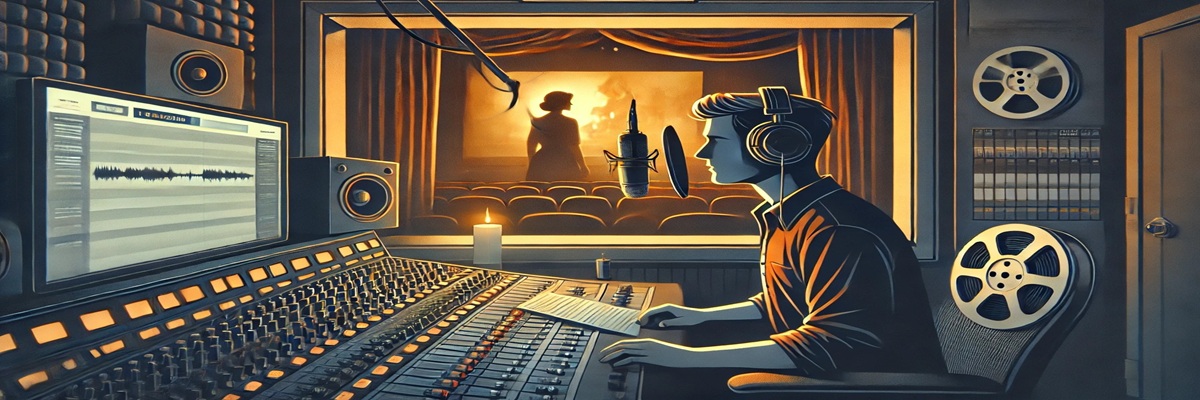In the world of film, voiceover has long been a storytelling device — from opening narrations that set the tone to inner monologues that deepen character arcs. But in 2025, voiceover is no longer confined to the margins of cinema. It’s increasingly integrated into marketing, storytelling, localization, and even theatrical experiences.
With new streaming strategies, global audiences, and voice-centric promotional content, the role of voiceover in the movie industry is not only growing — it’s evolving. And for voice actors, that shift is opening doors that were once exclusive to on-screen performers.
Expanding Role of Voiceover in Film Marketing
Movie trailers, promotional reels, behind-the-scenes docs, and studio featurettes now regularly feature voiceover narration. This isn’t new — but what’s changed is the tone and intent.
Studios in 2025 are moving away from the deep “In a world…” voiceover cliché and embracing a more natural, story-driven approach to trailer narration. The goal is emotional engagement, not bombast. The narrator’s job is to guide the mood, not announce it.
Many promotional voiceovers now feature first-person perspectives, character quotes, or thematic narration that adds depth without overwhelming the visuals. As a result, voice actors who can convey story presence without over-performing are being booked for high-profile marketing campaigns — not just generic trailers.
This shift has turned promotional VO into a storytelling extension, allowing voice talent to become recognizable contributors to a film’s launch.
Multilingual VO for Global Theatrical Releases
With simultaneous global premieres becoming the standard for major film studios, localization strategies have reached new levels of sophistication. Voiceover is now central to how international audiences access film content, particularly in territories where dubbing is not preferred.
Narrated content — such as press conferences, premiere livestreams, actor Q&As, and production documentaries — is often localized through voiceover rather than full re-records. These projects call for accurate timing, cultural sensitivity, and narrative alignment. For voice actors skilled in international work, this is a growing niche.
Studios are also embracing narrated accessibility tracks, where a voiceover artist provides descriptive audio for visually impaired audiences during theatrical releases or streaming premieres. These performances require clarity, restraint, and a deep understanding of cinematic rhythm.
The Voice of the Documentary
The documentary boom continues into 2025, with narrative nonfiction films gaining momentum across both theatrical and streaming platforms. Voiceover in this space serves multiple roles — narrator, character, interpreter, even conscience.
Documentary VO no longer leans heavily on the omniscient, objective tone. Instead, many docs now embrace first-person, confessional, or even poetic narration that mirrors the tone of the subject matter. Voice actors cast in these roles are selected as much for their vocal personality as for their technical delivery.
For example, recent award-winning documentaries have used multiple narrators, including real-life subjects and professional voice talent, to create layered emotional experiences. This trend offers meaningful opportunities for voice actors who excel in grounded, emotionally present performances.
Voiceover in Movie-Based Content Ecosystems
Movies today rarely live alone. Most are part of an expanded content ecosystem that includes podcasts, web exclusives, video essays, recap shows, and companion audiobooks. Voiceover is a connective tissue across these extensions.
In the lead-up to major releases, studios increasingly commission short-form or serialized content narrated by voice actors — providing backstory, character profiles, or universe-building elements. For example, a sci-fi film might release a 10-episode prequel audio series on a streaming platform, setting the stage for the cinematic release.
These storytelling formats create significant VO demand. Voice actors not only narrate; they become part of the film’s world. The performance must match the visual tone, language style, and emotional texture of the main release.
Big-Name Voice Talent in Animation and Beyond
Animation continues to lead the pack when it comes to voice-led cinematic experiences. In 2025, animated features dominate award categories, and celebrity-led voice casts remain the norm. But there’s growing criticism — and awareness — around the casting of well-known faces over skilled vocal performers.
As a result, studios are starting to mix marquee names with professional voice actors, especially in ensemble casts. There’s also a rising interest in bringing in established voice actors for character development, performance coaching, and background vocals.
For example, films produced by leading animation houses now regularly include non-celebrity voice talent in pivotal supporting roles — giving voice actors more meaningful screen time and audience recognition.
A New Appreciation for the Art of Voice Acting
In 2025, voice actors are finally receiving long-overdue recognition within the film industry. Industry panels, festivals, and fan conventions now include VO-centric programming. Award bodies have expanded categories for best voice performance, and social media has played a major role in celebrating the artistry behind the mic.
Fans are becoming more aware of who’s behind the voice — whether in animated blockbusters, indie films, or viral shorts. Online discussions frequently spotlight emotional reads, vocal chemistry, and line delivery choices, showcasing a deeper appreciation for the vocal side of performance.
For younger actors and those entering the industry, voiceover is no longer a fallback option or an invisible role. It’s a legitimate, high-impact craft with creative and commercial relevance.
The Voice Behind the Frame
As the film landscape continues to diversify — across format, distribution, and audience — voiceover remains one of its most adaptable tools. Whether offering access, emotion, expansion, or narrative clarity, the voice behind the frame is helping define what modern cinema feels like.
Voice actors are no longer just narrators or background contributors — they’re storytellers, tone-setters, and in many cases, the emotional bridge between a film and its audience.
In 2025, that bridge is not just holding — it’s leading the way forward.

